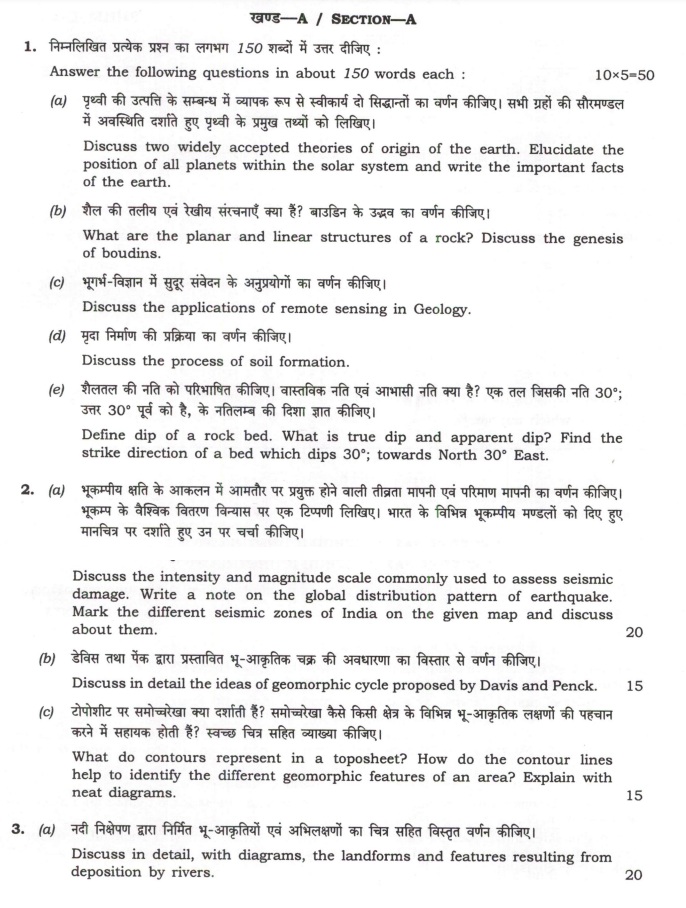(HOT) UPSC Current Affairs 2025 PDF
NEW! The Gist (NOV-2025) | E-BOOKS
(Download) UPSC MAIN EXAM : 2024 - GEOLOGY (Paper-1)

(Download) CS (MAIN) EXAM:2024 GEOLOGY (Paper I)
- Exam Name: CS (MAIN) EXAM:2024 GEOLOGY (Paper I)
- Marks: 250
- Time Allowed : Three Hours
खण्ड - A / SECTION — A
1. Answer the following questions in about 150 words each : 10×5=50
(a) Discuss two widely accepted theories of origin of the earth. Elucidate the position of all planets within the solar system and write the important facts of the earth.
(b) What are the planar and linear structures of a rock? Discuss the genesis of boudins.
(c) Discuss the applications of remote sensing in Geology.
(d) Discuss the process of soil formation.
(e) Define dip of a rock bed. What is true dip and apparent dip? Find the strike direction of a bed which dips 30°; towards North 30° East.
2. (a) Discuss the intensity and magnitude scale commonly used to assess seismic damage. Write a note on the global distribution pattern of earthquake. Mark the different seismic zones of India on the given map and discuss about them.
(b) Discuss in detail the ideas of geomorphic cycle proposed by Davis and Penck.
(c) What do contours represent in a toposheet? How do the contour lines help to identify the different geomorphic features of an area? Explain with neat diagrams.
3. (a) Discuss in detail, with diagrams, the landforms and features resulting from deposition by rivers.
(b) Describe the characteristics of Indian remote sensing satellites.
(c) Diagrammatically explain the formation of normal fault, strike-slip fault and thrust fault with the help of stress ellipsoid.
4. (a) Describe fold geometry. Illustrate various types of folds on the basis of their symmetry, orientation of axial plane and the trend of the fold axis.
(b) Describe and illustrate different types of plate boundaries, and explain the mechanism of plate motion.
(c) "At depth of compensation, the pressure generated by all overlying landmass substances on the earth is everywhere equal." Describe the hypotheses which support this statement.
खण्ड - B / SECTION — B
5. Answer the following questions in about 150 words each : 10 × 5 = 50
(a) Define species and explain how paleontological species are different from biological species.
(b) Discuss the geological parameters used to subdivide the Dharwar Craton into two subcratons.
(c) Describe the Cretaceous volcanic province in India.
(D) Describe how Darcy's law and Reynolds' number are related to the types of fluid flow in aquifers.
(e) Describe the rehabilitation measures required in landslide-affected area to restore the community and the ecology of the area affected.
6. (a) Elucidate the evolutionary trend of Proboscidea with examples.
(b) Describe lithostratigraphic classification and shift of depositional environments during deposition of the Vindhyan Supergroup. Comment on the age of the Vindhyan succession.
(c) Describe briefly the characteristics of different types of aquifers and also discuss the important properties that an aquifer should possess.
7. (a) Discuss the merits and limitations of different methods of stratigraphic analysis in brief. Comment on the most suitable method of stratigraphic analysis with justification.
(b) Describe in brief various types of organic-walled microfossils. Add a note on their biostratigraphic and paleogeographic significance.
(c) Describe the types of geological investigation required before construction of a highway in the Himalayas.
8. (a) Explain the concept of drainage basin morphometry. How do morphometric parameters influence the groundwater conditions of an area?
(b) Discuss various modes of preservation of fossils.
(c) Discuss the evolution of the Himalayas. Illustrate your answer with suitable labelled sketches.



